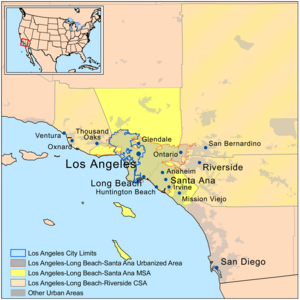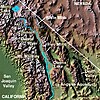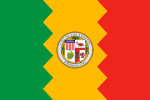The Greater Los Angeles Portal Greater Los Angeles is the most populous metropolitan area in the U.S. state of California, encompassing five counties in Southern California extending from Ventura County in the west to San Bernardino County and Riverside County in the east, with Los Angeles County in the center, and Orange County to the southeast. The Los Angeles–Anaheim–Riverside combined statistical area (CSA) covers 33,954 square miles (87,940 km2), making it the largest metropolitan region in the United States by land area. The contiguous urban area is 2,281 square miles (5,910 km2), whereas the remainder mostly consists of mountain and desert areas. With a population of 18.4 million in 2024, it is the second-largest metropolitan area in the country, behind New York, as well as one of the largest megacities in the world. In addition to being the nexus of the global entertainment industry, including films, television, and recorded music, Greater Los Angeles is also an important center of international trade, education, media, business, tourism, technology, and sports. It is the third-largest metropolitan area by nominal GDP in the world with an economy exceeding $1 trillion in output, behind New York City and Tokyo. There are three contiguous component urban areas in Greater Los Angeles: the Inland Empire, which can be broadly defined as Riverside and San Bernardino counties; the Ventura/Oxnard metropolitan area (Ventura County); and the Los Angeles metropolitan area (also known as Metropolitan Los Angeles or Metro LA) consisting of Los Angeles and Orange counties only. The Census Bureau designates the latter as the Los Angeles–Long Beach–Anaheim metropolitan statistical area (MSA), the fourth largest metropolitan area in the western hemisphere and the second-largest metropolitan area in the United States, by population of 13 million as of the 2020 U.S. census. It has a total area of 4,850 square miles (12,561 km2). Although San Diego–Tijuana borders the Greater Los Angeles area at San Clemente and Temecula, it is not part of it as the two urban areas are not geographically contiguous due to the presence of Camp Pendleton. However, both form part of the Southern California Megalopolis which extends into Tijuana, Baja California, Mexico. Throughout the 20th century, Greater Los Angeles was one of the fastest-growing regions in the United States, but growth has slowed since 2000. (Full article...) Selected article - The California Water Wars were a series of conflicts between the city of Los Angeles and farmers and ranchers in the Owens Valley of Eastern California. As Los Angeles grew in the late 1800s, it started to outgrow its water supply. Fred Eaton, mayor of Los Angeles, realized that water could flow from Owens Valley to Los Angeles via an aqueduct. The aqueduct construction was overseen by William Mulholland and was finished in 1913. The water rights were acquired through political fighting and, as described by one author, "chicanery, subterfuge ... and a strategy of lies." By the 1920s, so much water was diverted from the Owens Valley that agriculture became difficult. This led to the farmers trying to destroy the aqueduct in 1924. Los Angeles prevailed and kept the water flowing. By 1926, Owens Lake at the bottom of Owens Valley was completely dry due to water diversion. The water needs of Los Angeles kept growing. In 1941, Los Angeles diverted water that previously fed Mono Lake, north of Owens Valley, into the aqueduct. Mono Lake's ecosystem for migrating birds was threatened by dropping water levels. Between 1979 and 1994, David Gaines and the Mono Lake Committee engaged in litigation with Los Angeles. The litigation forced Los Angeles to stop diverting water from around Mono Lake, which has started to rise back to a level that can support its ecosystem. Did You Know -
March - June 2004 Selected imageWikiProject
Related PortalsSelected biography -Angelina Jolie (/dʒoʊˈliː/; born Angelina Jolie Voight; June 4, 1975) is an American actress, filmmaker, and humanitarian. The recipient of numerous accolades, including an Academy Award and three Golden Globe Awards, she has been named Hollywood's highest-paid actress multiple times. Jolie made her screen debut as a child alongside her father, Jon Voight, in Lookin' to Get Out (1982). Her film career began in earnest a decade later with the low-budget production Cyborg 2 (1993), followed by her first leading role in Hackers (1995). After starring in the biographical television films George Wallace (1997) and Gia (1998), Jolie won the Academy Award for Best Supporting Actress for playing a sociopath in the 1999 drama Girl, Interrupted. Her portrayal of the titular heroine in Lara Croft: Tomb Raider (2001) established her as a household name. Her fame continued with roles in the action films Mr. & Mrs. Smith (2005), Wanted (2008), and Salt (2010). She also received acclaim for her performances in the dramas A Mighty Heart (2007) and Changeling (2008), the latter earning her a nomination for the Academy Award for Best Actress. Her other commercial successes include the fantasy film Maleficent (2014), its 2019 sequel, and the superhero film Eternals (2021). She played a voice role in the Kung Fu Panda animated film series from 2008 to 2016. Jolie has directed and written the war dramas In the Land of Blood and Honey (2011), Unbroken (2014), and First They Killed My Father (2017). (Full article...)Regions, major cities and districtsRegions
Cities
Cities by countyTopicsCategoriesSelect [►] to view subcategories
Greater Los Angeles
Los Angeles County, California
Orange County, California
Ventura County, California
WikimediaThe following Wikimedia Foundation sister projects provide more on this subject:
Discover Wikipedia using portals |









































